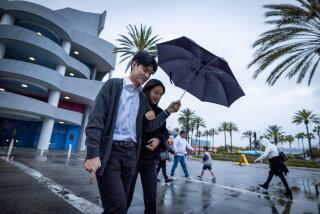Rain May Allow More Pumping to Urban Areas
With California’s heavy rains came new predictions from state authorities Tuesday that more water can be allocated to urban users than had been projected before the March storms struck; there was even a suggestion that some drought rationing plans may become less stringent.
Although that was good news for thirsty Southern California, the storm that passed through Southern California late Monday and early Tuesday also carried freak, tornado-like winds that upended a boat docked in Newport Beach, caused widespread power outages in Orange County and damaged homes in San Diego, Lakewood and Bellflower.
For the record:
12:00 a.m. March 21, 1991 For the Record
Los Angeles Times Thursday March 21, 1991 Home Edition Part A Page 3 Column 1 Metro Desk 1 inches; 26 words Type of Material: Correction
Reservoirs--Because of an editing error, the location of the San Luis Reservoir was incorrect in an article in Wednesday’s editions of the Times. It is in Merced County near Los Banos.
The downpour was also responsible for nearly two dozen accidents on Orange County freeways and scattered incidents of flash flooding and mudslides elsewhere.
Forecasters said showers probably would return to the Southland by this morning and continue through Thursday. Meanwhile, a storm carrying an inch of rain or more was expected Thursday in Northern California.
Because the month has produced twice the normal rainfall in large parts of the state, an official of the Department of Water Resources said it has been possible every day since March 4 to pump the maximum amount of water allowable by state regulations from the Sacramento-San Joaquin River Delta to the all-important San Luis Reservoir in Kern County.
The reservoir is the key storage place for water that is drawn from the northern part of the state and ultimately shipped along the California Aqueduct to customers in Southern California.
Shipments from the reservoir had been reduced by state water officials because the levels were dangerously low.
But Larry Gage, chief of the schedules and analysis branch of the Department of Water Resources, said it was very likely that the allocations for the rest of the year could be increased--although not necessarily dramatically--at the next supply review by state water officials in early April.
Jennifer Persike, a spokeswoman for the Assn. of California Water Agencies, said that while no agency has yet decided to make water rationing less stringent, “that may come after the storms have settled down and everybody is better able to determine what they have. I know that state and federal agencies are all trying to size up what these storms have meant.”
Although San Diego Mayor Maureen O’Connor, an adamant foe of water rationing, asked state officials to declare the drought over and to distribute all water from the latest storms, the Water Resources Department’s Drought Center said such a move would not be made.
Even a year of normal rainfall statewide would not lead to an end of the drought declaration because much more rain would be needed to fill reservoirs and replenish ground water basins, said Dee Davis of the Drought Center.
At the federal Bureau of Reclamation, spokeswoman Linette Wirth said that while March rainfall figures “are looking good,” no announcements of federal water allocation changes will be made until mid-April.
She noted that some of the heaviest rains have fallen in Southern California, outside the most important water storage areas of the Sierra and Cascades and that four key Northern California reservoirs remain well below normal storage figures for this time of year.
Wirth said the Shasta Reservoir north of Redding was at 54% of normal early this week. The Claire Engle on the Trinity River was at 56% of normal; Folsom, east of Sacramento, 53% of normal, and the New Melones Reservoir, southeast of Sacramento, only 28% of normal.
By contrast, after Ventura received five inches of rain in the latest storm ending early Tuesday, Ventura County authorities reported that their Casitas Reservoir was 100% of normal for this time of year and filled to 51% of its total capacity. For the first time since 1986, Ventura city rainfall was above normal for the season.
Santa Barbara authorities also said that the five to 11 inches of rain that fell in the county’s mountainous areas in the storm had insured that the Cachuma Reservoir would not run out of water until at least 1993. Only Monday, the same authorities had predicted that mid-1992 would be the run-dry date.
The smaller Gibraltar Reservoir, which usually provides the city of Santa Barbara with 30% of its water but had not provided any recently, filled up Tuesday and water had to be spilled out of it.
While drought experts were assessing the effect of the rain, others were assessing the damage wrought by high winds.
CHP officials said more than 20 accidents occurred on Orange County freeways between 10 p.m. Monday and 2 a.m. Tuesday when the rain came down in sheets. None of the accidents were serious, however.
“We didn’t get enough rainfall to create all that much havoc,” spokeswoman Angel Johnson said.
Ortega Highway, closed briefly earlier this month after torrential rain triggered heavy mudslides, faced some flooding early Tuesday but not enough to shut down the highway, Johnson said.
Authorities said high winds were responsible for unmooring and sinking a 42-foot commercial fishing boat docked in Newport Harbor.
Harbor patrol officials found the overturned and partly submerged vessel about 2:30 a.m. Tuesday after receiving radio reports of a large craft listing. Strong gales apparently yanked the vessel from a mooring buoy, ripping off an 8-by-3-foot section of the stern and flooding the boat, sheriff’s spokesman Lt. Richard J. Olson said.
The roof of the boat had also been blown off and apparently floated down the channel, he said. No one was injured.
About 100 homes were damaged by high winds in the San Carlos area of San Diego, including one that lost its roof. Trees fell on parked automobiles and a refrigerator was blown from one lot to another.
In Carson, Lakewood, Bellflower, Compton and Long Beach, wind shattered windows, uprooted trees and ripped tiles from roofs. A small funnel that touched down in Lakewood shattered a billboard and downed power lines. A tree crashed through a living room window in Bellflower.
In San Clemente, rain and winds gusting up to 40 m.p.h. blew out fuses and cut off electricity supply to more than 1,000 customers, San Diego Gas & Electric spokesman Fred Vaughn said. Power was restored after a few hours.
More than 100 customers around the rest of the county also experienced blackouts ranging from a few seconds to several hours, according to a spokesman for Southern California Edison. Rain, wind and scattered bolts of lightning apparently knocked out fuses.
Mudslides closed many roads in both Ventura and Santa Barbara counties.
Los Angeles Civic Center received 1.48 inches of rain in the storm, bringing its total rainfall for the year to 6.86 inches, still well below the normal for this time of year of 12.64 inches, but above last year’s figure of 5.61 inches.
Rainfall totaled 1.27 inches in El Toro, 1.29 inches in Long Beach, 1.73 inches in Monrovia, 3.23 inches at Mt. Wilson, 2.74 inches at Point Mugu and 2.59 inches in Santa Barbara.
Forecasts said showers would probably hit the Southland by this morning and continue today and Thursday. Meanwhile, a storm carrying an inch of rain or more was expected Thursday in Northern California.
Times staff writers Joanna M. Miller in Ventura and Miles Corwin in Santa Barbara also contributed to this article.
THE RAIN 24-hour total: .81 Storm total: .81 Monthly total: 1.88 Total for season: 8.04 inches Last season to date: 7.53 inches Normal season to date: 10.56 inches
Figures, based on 3 p.m. readings in Santa Ana, are compiled by WeatherData Inc.
More to Read
Sign up for Essential California
The most important California stories and recommendations in your inbox every morning.
You may occasionally receive promotional content from the Los Angeles Times.











